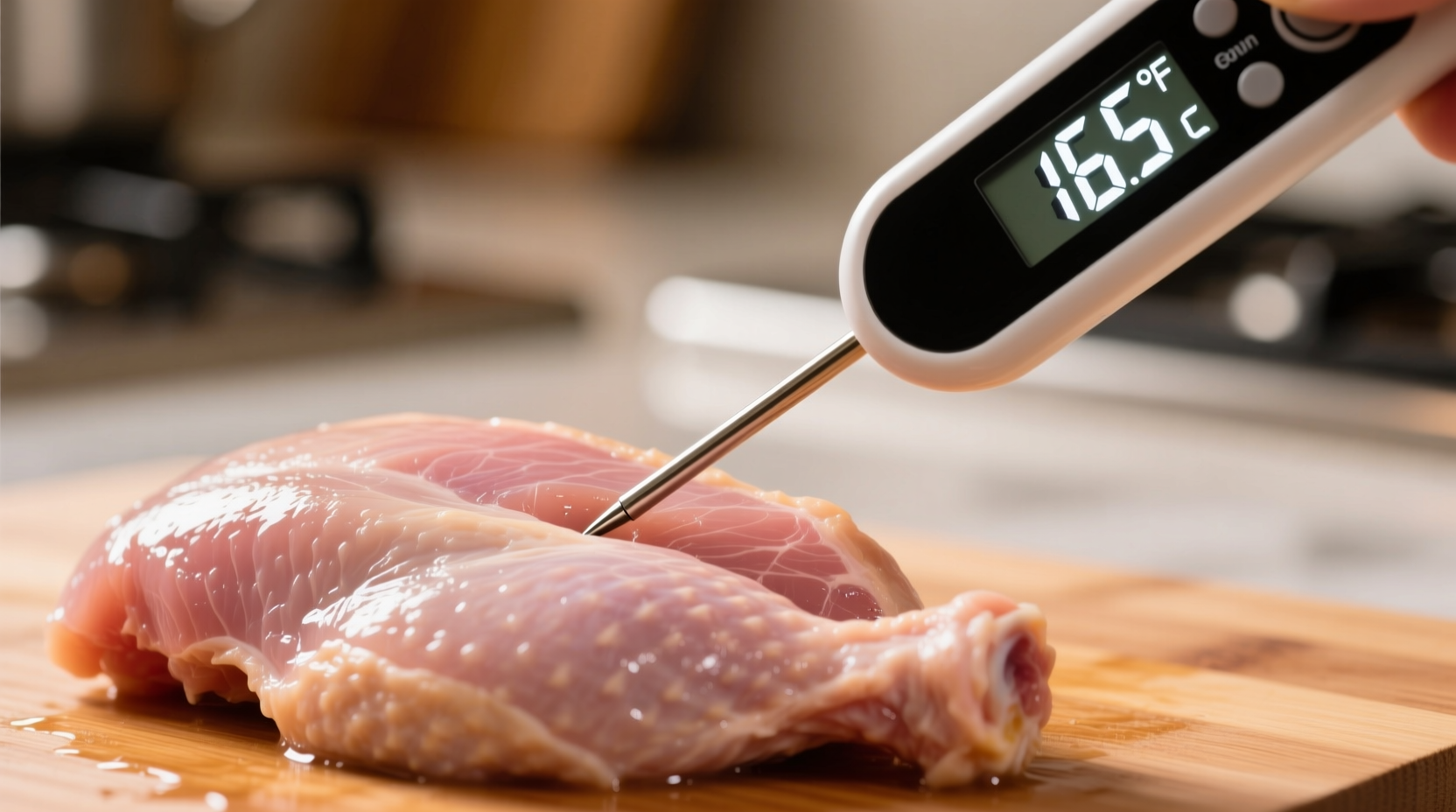The safe minimum internal temperature for cooking all chicken is 165°F (74°C), as verified by the USDA Food Safety and Inspection Service. This temperature destroys harmful bacteria like Salmonella and Campylobacter, making your chicken safe to eat while preserving optimal texture and moisture.
When you're preparing chicken, knowing the exact temperature isn't just about safety—it's the difference between dry, overcooked poultry and juicy, perfectly prepared meals. As a home cook, you deserve clear, actionable guidance that keeps your family safe while delivering restaurant-quality results.
Why 165°F Is Your Chicken's Safety Threshold
Understanding the science behind safe cooking temperatures transforms how you approach poultry preparation. The USDA's recommendation of 165°F (74°C) isn't arbitrary—it's the precise temperature at which dangerous pathogens like Salmonella and Campylobacter are instantly destroyed.
According to the USDA Food Safety and Inspection Service, "Cook all poultry to an internal temperature of 165°F as measured with a food thermometer." This standard applies to all chicken cuts—breasts, thighs, wings, and whole birds.
| Chicken Cut | Minimum Safe Temperature | Recommended Target for Best Results |
|---|---|---|
| Chicken breasts | 165°F (74°C) | 160-162°F (71-72°C) with resting |
| Thighs & drumsticks | 165°F (74°C) | 175-180°F (79-82°C) |
| Whole chicken | 165°F (74°C) | 160°F (71°C) in breast, 175°F (79°C) in thigh |
| Ground chicken | 165°F (74°C) | 165°F (74°C) |
The Right Way to Check Chicken Temperature
Many home cooks make critical errors when checking chicken temperature that compromise safety. Follow these professional techniques for accurate readings:
- Use a digital instant-read thermometer — Dial thermometers are too slow and inaccurate for thin chicken cuts
- Insert at the thickest part — Avoiding bone, fat, or gristle which give false readings
- Check multiple spots — Especially in larger cuts like whole chickens or stuffed breasts
- Wait 15 seconds — For digital thermometers to stabilize before reading
The FDA Food Code specifies that thermometers used for food safety must be accurate within ±2°F (±1°C). Calibrate your thermometer regularly using the ice water (32°F/0°C) or boiling water (212°F/100°C) method to ensure precision.

Temperature Nuances for Different Chicken Cuts
While 165°F remains the safety threshold for all chicken, different cuts benefit from slightly different target temperatures for optimal texture:
Cooking chicken breasts
Chicken breasts are lean and dry out quickly when overcooked. Aim for 160-162°F (71-72°C) before removing from heat, as carryover cooking will bring them to the safe 165°F mark during the 5-10 minute resting period. This approach prevents the rubbery texture that occurs when breasts hit 170°F+.
Cooking thighs and drumsticks
Dark meat contains more connective tissue that requires higher temperatures to break down properly. While 165°F makes thighs safe to eat, they'll be rubbery and unpleasant. Cook thighs to 175-180°F (79-82°C) for tender, juicy results as collagen converts to gelatin.
Whole chicken considerations
When roasting a whole chicken, monitor both breast and thigh temperatures separately. The breast should reach 160°F (71°C) while the thigh should hit 175°F (79°C). This differential cooking accounts for the different fat contents and muscle structures.
Avoiding Common Temperature Mistakes
Even experienced cooks make these critical errors that compromise safety or quality:
- Mistake: Relying on color or juices running clear
Reality: Chicken can appear cooked before reaching safe temperatures, and pink hues can remain even after proper cooking due to myoglobin - Mistake: Not accounting for carryover cooking
Reality: Chicken continues cooking 5-10°F after removal from heat—remove breasts at 160°F for perfect results - Mistake: Checking temperature too early
Reality: Opening the oven or grill frequently drops temperature—wait until the final minutes to check
The CDC reports that Salmonella causes approximately 1.35 million infections annually in the United States, with improperly cooked poultry being a primary source. Following precise temperature guidelines significantly reduces this risk.
When You Don't Have a Thermometer
While a thermometer is essential for food safety, these visual indicators can serve as secondary checks:
- Juices run clear — No pink or red tint
- Firm texture — Breasts spring back when pressed, not soft or squishy
- Meat separates easily — From bone in wings and drumsticks
However, these methods alone aren't reliable for determining safety. The only guaranteed method to ensure chicken is properly cooked is using a calibrated food thermometer. Consider investing in a high-quality instant-read thermometer—it's the single most important tool for safe poultry preparation.
Resting Time and Carryover Cooking Explained
Many cooks don't realize that chicken continues cooking after removal from heat. This phenomenon, called carryover cooking, adds 5-10°F to the internal temperature during the resting period.
For best results:
- Remove chicken breasts at 160-162°F (71-72°C)
- Rest covered with foil for 5-10 minutes
- Final temperature will reach the safe 165°F (74°C) mark
This technique prevents overcooking while ensuring safety. For thicker cuts like whole chickens, resting time should be 15-20 minutes to allow juices to redistribute properly.
Special Considerations for Different Cooking Methods
Various cooking techniques affect how chicken reaches safe temperatures:
- Grilling: Direct heat requires careful monitoring as exterior can char before interior reaches safe temperature
- Sous vide: Can cook at lower temperatures (145-150°F/63-66°C) for extended periods, but must follow precise time/temperature tables
- Frying: Oil temperature (350°F/177°C) creates rapid exterior cooking—verify internal temperature with thermometer
Remember that regardless of cooking method, the internal temperature must reach 165°F (74°C) for safety. Don't rely solely on cooking times, as variables like starting temperature, thickness, and equipment differences significantly impact results.











 浙公网安备
33010002000092号
浙公网安备
33010002000092号 浙B2-20120091-4
浙B2-20120091-4